Salesforce is only a CRM tool, whereas the true lifeblood of each business is the data. And to make it work to your benefit, it should be accurate and consistent across all the systems.
That’s when ETL Salesforce tools come in.
In this article, we’ll show:
- Why integrate data to and from Salesforce?
- What role does the data warehouse play in practical insights management?
- How ETL tools in Salesforce may overcome data integration challenges.
- What is the best ETL tool for Salesforce?
Table of contents
- What is Salesforce?
- Why Salesforce Is Not the Same As a Data Warehouse
- How Data Integration from Salesforce to Data Warehouse Can Help
- Common Salesforce Data Integration Challenges
- What are ETL Tools?
- What are ETL Tools in Salesforce?
- 9 Best ETL Tools for Salesforce in 2025
- How to Choose the Right Salesforce ETL Tool
- Best Practices for Salesforce ETL
- Conclusion
What is Salesforce?

It’s a robust cloud-based customer relationship management (CRM) platform that, for 20+ years, has gone way beyond this concept and turned into a unique, self-sufficient ecosystem. The service includes products for various purposes, like:
- Sales and marketing automation.
- Application development.
- Advanced data analysis.
Thanks to its infrastructure and agility, the company remains a #1 CRM provider for the eighth year.
Why Salesforce Is Not the Same As a Data Warehouse
Your business data must be consolidated and easily retrievable to get a 360-degree view of customer interactions. Unfortunately, despite all the apparent strengths of Salesforce, it has data storage and management limitations.
Multi-Tenant Nature
Since Salesforce is a cloud-based technology, many organizations share the same platform resources. And to make this coexistence possible, each company is limited in the data storage capacity within their system. As a result, it is usually not enough for medium and large organizations. In addition, it can cost extra dollars to expand this storage space.
Slow Data Transfer Time
Since the amount of data each company stores varies significantly, response time to specific queries may also vary. Some calls can take hours to pull necessary data and create a comprehensive report.
Per-Transition Limits
Salesforce has query limits that restrict manipulations with extensive data flows within the CRM. So, if you need to import/export many records daily, you can quickly hit these limits.
Complex Data Relationships
Salesforce organizes data using a structured relational model built around objects, relationships, and dependencies. This structure is optimized for CRM operations like managing leads, opportunities, and activities. However, performing complex analytics across multiple objects is challenging.
Running multi-level joins or aggregations across related objects often requires custom reports, workarounds, or external tools.
In contrast, data warehouses are designed with query performance and analytical flexibility in mind, allowing for simplified relationships, denormalization, and schema optimization.
It often needs to be extracted, transformed, and restructured to make Salesforce data analytics-ready, especially when combining it with other data sources or running advanced BI and machine learning workflows.
Storage Costs and Limits
Salesforce imposes strict storage limits on records, files, and attachments, making retaining large datasets within the platform costly. Although additional storage is available, it comes at a significant premium, especially for high-growth businesses. These constraints often force companies to offload historical or less frequently accessed data to external storage or cloud data warehouses. As a result, implementing ETL or data integration solutions becomes a perfect solution to manage storage efficiently while maintaining access to valuable business data.
How Data Integration from Salesforce to Data Warehouse Can Help
The good news is that data warehousing solutions can prevent the abovementioned issues. Amazon Redshift, Snowflake, and Google Big Query are the most famous examples. They are designed to accumulate and analyze large data volumes from databases and other sources.
Thanks to this, you can:
- Get a unified view of the customer information by eliminating unnecessary data layers.
- Increase efficiency and become a true master of your business data.
- Improve data quality, thanks to the consolidation of sources.
Since Salesforce wasn’t primarily created as a data repository, you need to build a proper Salesforce warehouse synchronization strategy and data integration model to leverage the full power of these two software types. In this way, you should deal with specific challenges.
Common Salesforce Data Integration Challenges
Salesforce users often consider data integration as their primary challenge. Before launching this process, you should see the risks you may face, such as:
- No understanding of the data integration scope.
- Lack of clear integration strategy.
- Misselection of the integration solution.
- Poor data quality and data gaps.
- Mismatch of data and field types in systems.
- No data validation rules.
- Lack of understanding of objects’ relationship within solutions.
- Underestimation of systems and processes complexity.
As mentioned earlier, you can mitigate most troubles by creating a data quality policy and choosing the best ETL tool for Salesforce.
What are ETL Tools?
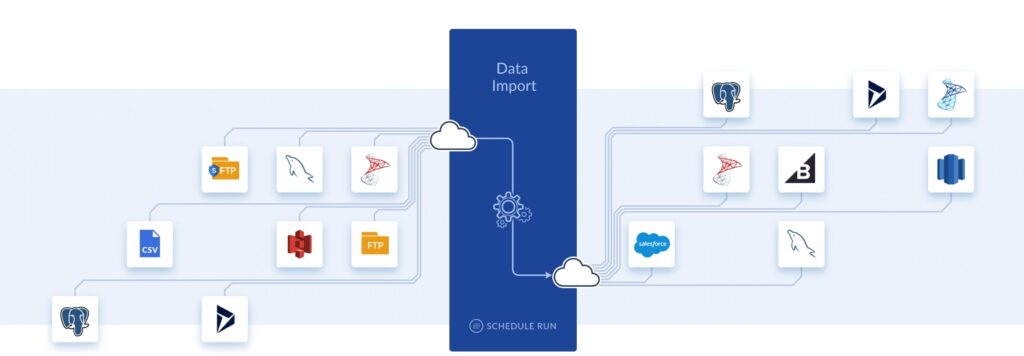
These systems are a must-have in modern data management and integration. Extract, Transform, and Load (ETL) tools help organizations:
- Gather data from various sources.
- Transform it into a consistent and usable format.
- Load it into target systems such as databases, data warehouses, or cloud storage.
ETL platforms automate and streamline this multi-step process, making it easier for businesses to maintain clean, organized, and analytics-ready data. They support business intelligence, reporting, machine learning, and operational efficiency.
What are ETL Tools in Salesforce?
Now, we’re talking about the most popular ones when connecting a DWH with the Salesforce platform. They help automate the management of the ETL pipelines and standardize data for further analysis.
Simply put, these platforms extract the data from several sources, integrate it with the database, and store it with/without transformations in a data warehouse. Moreover, ETL tools can test the data pipelines and analyze the reports of the performed runs.
Over 150 ETL tools available on the market can work with Salesforce. Some are designed for beginners with no programming background; others require some coding skills. We’ve carefully analyzed all the software leaders’ pros and cons to present you with their detailed review below.
9 Best ETL Tools for Salesforce in 2025
Skyvia

Skyvia is a powerful integration platform for solving different data-related tasks, including ETL from Salesforce to a data warehouse and vice versa, ELT from Salesforce to a data warehouse, many other tools, and Reverse ETL.
It allows users to quickly copy Salesforce data to a data warehouse as is or configure an ETL process with data transformations to fit an existing schema. When needed, the data can be reuploaded back to Salesforce or even published as OData and linked to Salesforce as external objects.
PROS
- Easy no-coding tools to copy cloud data to a database or data warehouse.
- Over 200 connectors.
- Advanced transformation capabilities with powerful mapping.
- A number of different data-related tools in one platform.
- Ability to load data between cloud apps and databases in any direction.
- Comprehensive documentation and tutorials.
CONS
- No support for NoSQL databases like MongoDB.
- No 24/7 support.
- No on-premise option.
ETLeap
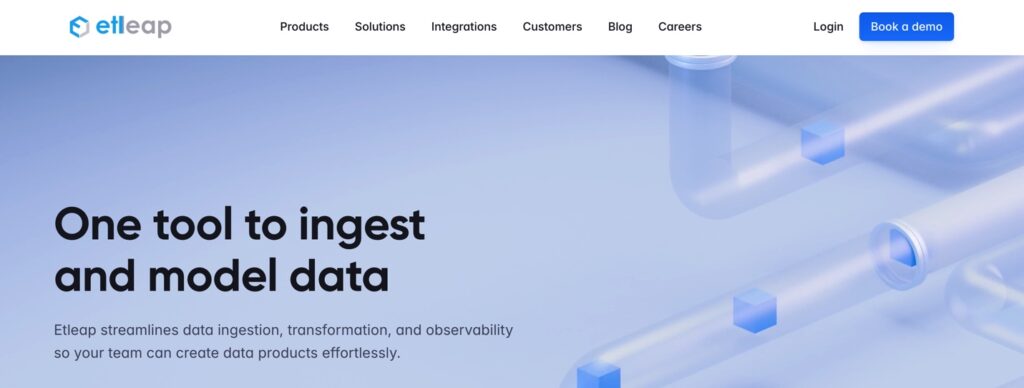
ETLeap is also one of the top Salesforce data extraction tools that helps connect data from various sources to data warehouses like Redshift or Snowflake. It’s designed for users with no development skills, so any data analyst can easily configure it without heavy coding. Like many other leading big data software on the market, it’s cloud-based, so you don’t have to involve IT resources to install and support it.
PROS
- Has 75+ connectors.
- No-code ETL functionality is analyst-friendly.
- Allows pre-load transformation via Data Wrangler and SQL.
- It has an on-premise option (AWS VCP).
CONS
- For some custom API connectors (via user-defined API) or advanced use cases, light scripting or manual configuration may be required.
- Enterprise users may face a learning curve when dealing with advanced data modeling or integrations.
Stitchdata
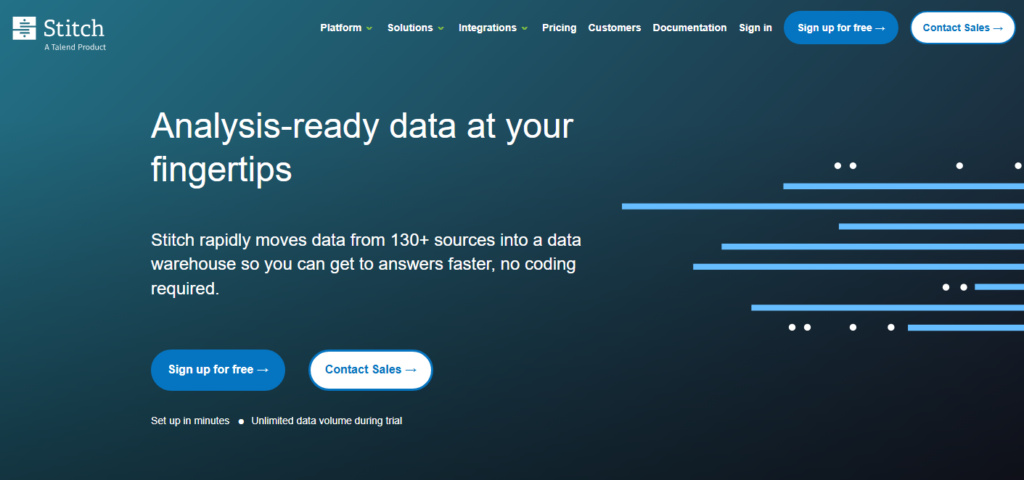
Stitchdata by Talend is a robust, cloud-first ETL service tool for Salesforce users of all business sizes. It enables high-volume data transfers from cloud-based apps and databases to data warehouses.
It allows users to leverage transformed and unified data for reporting and better decision-making. With its simple setup and prebuilt connectors, the platform makes it easy to launch data pipelines without extensive engineering resources.
PROS
- It has 130 nearly-native connectors.
- It can be integrated with ten popular data warehousing solutions.
- Allows adding new data sources via Singer.
- Has detailed documentation.
CONS
- Advanced users or organizations seeking to programmatically manage their Stitch accounts or build custom integrations may utilize the Stitch Connect API.
- Particular APIs (e.g., QuickBooks) do hard deletes of objects, and the Stitchdata tool replicates them.
Workato

Workato is a cloud integration platform as a service (iPaaS) software that helps organizations integrate thousands of apps with Salesforce and consolidate data to turn it into actionable insights. This low-code tool enables fast business workflow automation and massive data aggregation across these apps.
It supports real-time and event-driven triggers, which is fine for time-sensitive operations like lead routing or order processing. With built-in AI and hundreds of prebuilt recipes, Workato empowers both IT teams and business users to create scalable integrations without deep coding expertise.
PROS
- Convenient UI/UX and easy implementation.
- Maintenance-free functionality.
- Reusable connectors and managed file transfers.
- Easy and transparent job monitoring.
CONS
- Workato supports API endpoint caching and lookup tables, to enhance performance. However, there are limitations on the volume of data that can be effectively cached within the platform.
- Mastering advanced features and complex workflows may require a significant learning investment.
Fivetran
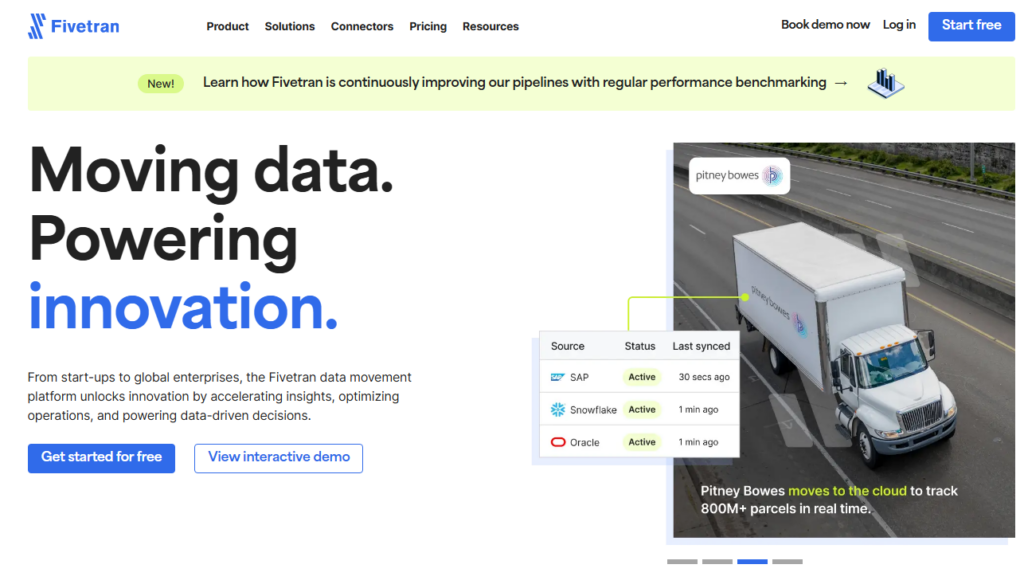
Like other above-reviewed Salesforce ETL tools, Fivetran allows automatic data copying from Salesforce to the data warehouse. In addition, it offers many pre-built connectors to meet the real-world needs of data analysts. This data integration software doesn’t require maintenance from your side and can be easily deployed and adjusted.
It also supports schema drift handling, ensuring new fields in Salesforce are automatically captured without manual reconfiguration. The solution is especially suited for teams looking for a reliable, set-it-and-forget-it data pipeline.
PROS
- Over 500 out-of-the-box connectors.
- Allows post-load data transformation via SQL.
- Can synchronize with a lot of typical data warehouses.
- Allows adding new data sources via Cloud Functions.
CONS
- No sync schedule by a fixed time.
- Needs improvement in the bulk field adding/deletion controls.
- Advanced operations or custom integrations may necessitate the use of the REST API available for Standard, Enterprise, or Business Critical plans, and during trial periods. Therefore, leveraging the API for extended functionalities may require these specific account tiers.
Lyftron
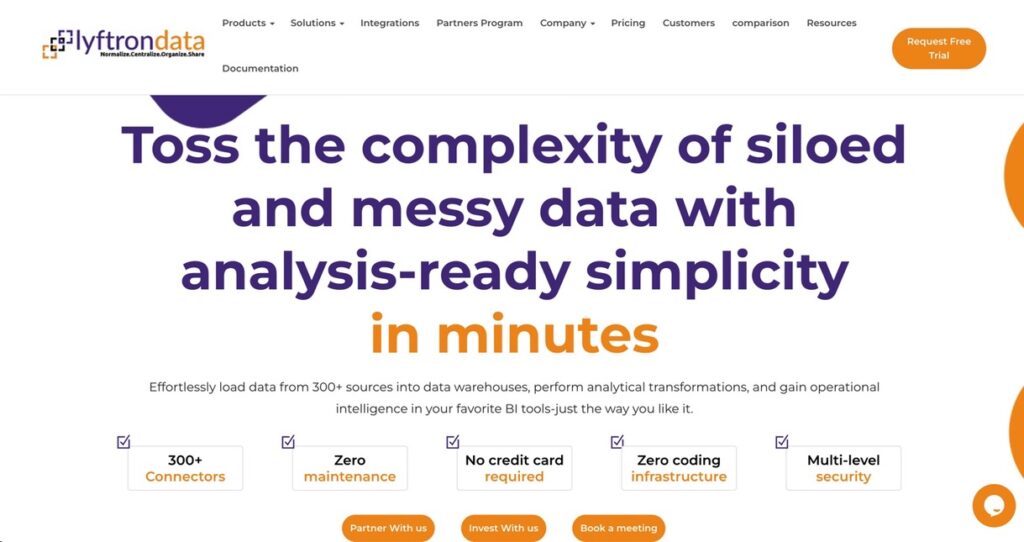
Lyftron is a Salesforce data extraction and load tool for the streamlined processing of large sets of information and the removal of data pipeline roadblocks. It enables data professionals to create and manage data flows within one platform and increase productivity.
With built-in data virtualization and automatic schema detection, the system allows real-time querying across multiple data sources. It also supports ELT transformations using ANSI SQL, making it accessible for both analysts and engineers.
PROS
- Has 300+ pre-built connectors.
- Provides an on-premise integration option.
- Offers 19 data destinations.
- Allows pre-load and post-load data transformation via SQL.
CONS
- Limited community and user feedback.
- Steeper learning curve for new users.
- Few third-party reviews or benchmarks.
- Potential concerns around long-term vendor maturity and support.
Segment

Segment (aka Twilio Segment) ETL solution also helps streamline the processing of data from Salesforce and other data sources with an additional focus on event tracking. This platform allows businesses to accumulate, unify, and map customer data to and from Salesforce.
Its real-time pipelines ensure that customer behavior data is immediately routed to analytics tools, marketing platforms, or data warehouses. The tool is especially useful for building personalized user experiences, tracking customer journeys, and syncing behavioral data across multiple systems.
PROS
- It has an extensive list of out-of-the-box 800 connectors.
- Allows adding new data sources via the available sources offered on the Segment platform.
- Can integrate into six data warehouses.
- It enables data transformation and customization for a particular destination.
CONS
- Has no on-premise option.
- May require extra developing tools for custom data collection and integration.
- Custom integrations may require a solid understanding of the platform’s API and data structures.
Integrate.io

Integrate.io enables integration of Salesforce with major data warehouses. This no-code software helps create a single source of truth via real-time data replication and a plug-and-play interface. In addition, the Xplenty solution allows data analysts and engineers to deploy custom transformations in a few minutes.
It supports pre-built connectors for a wide range of sources, making setup fast and efficient. With built-in scheduling, monitoring, and error handling, users can automate workflows and maintain data integrity with minimal oversight.
PROS
- Has over 200 pre-built connectors.
- Enables data transformation and filtering.
- It doesn’t require coding skills for the tool setup and management.
- Easy job progress tracking.
- No-code API generation.
CONS
- Limited advanced customization for complex workflows.
- Some connectors may require manual schema mapping.
- Pricing can become high for large-scale data volumes.
- Occasional delays in real-time sync performance.
Matillion ETL
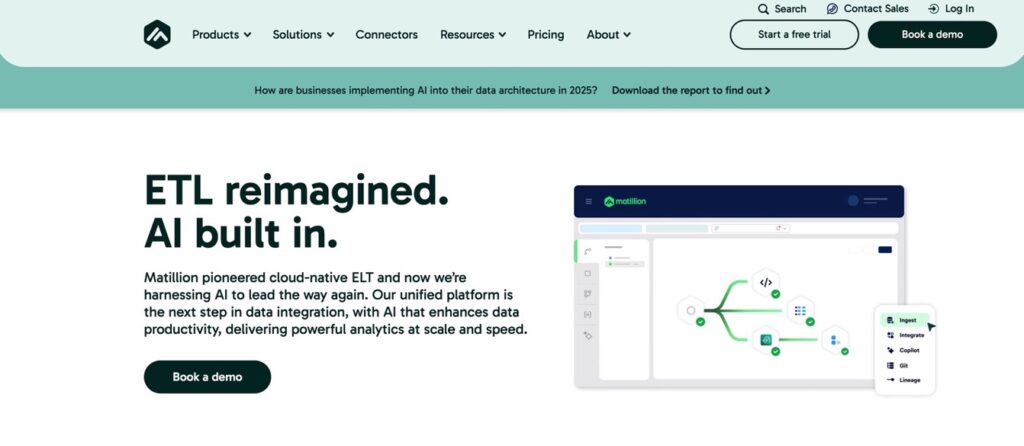
Matillion ETL helps overcome data inconsistencies in your systems that may arise and build higher confidence in it. This cloud-based tool enables easy data integration and transformation, which helps reach new levels of efficiency and productivity.
It offers deep integration with major cloud data warehouses like Snowflake, Redshift, and BigQuery. With its visual interface and support for both no-code and SQL-based transformations, teams can accelerate development without sacrificing flexibility.
PROS
- It has over 150 nearly-native connectors.
- Ability to connect on-premise sources via Progress DataDirect Hybrid Data Pipeline.
- Enables pre-load data transformation via SQL.
- Allows the creation of custom connectors with the API Extract functionality in Matillion ETL.
CONS
- Requires strong SQL knowledge for building complex workflows.
- Limited support for advanced data science or ML integrations.
- Costs can be high for smaller teams or startups.
- UI may become cluttered when managing large numbers of jobs.
- Lacks native support for unstructured or semi-structured NoSQL data sources.
How to Choose the Right Salesforce ETL Tool
Selecting the right ETL tool for Salesforce depends on the company’s size, technical expertise, and integration goals.
Let’s review the key factors to decide what to select:
- Business Requirements. Define if you need simple one-way data extraction, bi-directional sync, or complex multi-system integration. Each choice should align with how often and how much data you move.
- Ease of Use vs. Flexibility. No-code platforms like Skyvia or Integrate.io are great for non-technical teams. However, if the workflows demand more profound control and customization, tools like Matillion or Fivetran offer more power at the cost of a steeper learning curve.
- Real-Time vs. Batch Processing. If near-instant updates are essential (e.g., lead-to-order processes), look for tools with real-time sync capabilities like Workato or Segment. For periodic data loads, batch-focused tools such as Stitch or Lyftron may be sufficient.
- Scalability and Performance. As the data grows, so do integration demands. Choose a tool that can scale horizontally, handle schema changes automatically, and maintain high throughput, especially for large Salesforce orgs.
- Data Transformation Needs. Some tools only support post-load transformation (e.g., ELT), while others allow pre-load transformations via SQL or visual mapping. Consider how much control you need over cleaning and reshaping data before it hits the destination.
- Cost and Licensing. Evaluate both initial and ongoing costs, especially for tools that are based on volume or connector usage. Free trials and transparent pricing (like Skyvia’s) help with budgeting and comparisons.
- Security & Compliance. Ensure the tool meets compliance standards (GDPR, HIPAA, SOC 2, etc.) and offers role-based access, audit logs, and secure data transfers.
Best Practices for Salesforce ETL
To get the most value from the Salesforce ETL process, follow these best practices to ensure accuracy, performance, and maintainability:
- Understand Your Data Model First. Before extracting anything, map out Salesforce objects and relationships: custom vs. standard fields, lookup fields, and object dependencies to avoid downstream broken joins and incomplete records.
- Use Incremental Loads. Avoid pulling the full dataset every time. Instead, use filters like LastModifiedDate or CDC (Change Data Capture) to extract only what changed to reduce load times and API usage.
- Maintain Data Quality Early. Apply transformations, validations, and deduplication rules as early as possible in the pipeline. Clean data at the start prevents bad data from propagating through the systems.
- Test in Sandbox Before Production. Always develop and test the ETL flows in a Salesforce Sandbox or staging environment to prevent accidental data loss or corruption in production.
- Monitor and Audit Your Jobs. Set up alerts and logging to monitor failed jobs, API call usage, and sync delays. Many tools, like Fivetran and Skyvia, offer built-in job monitoring features.
- Document and Version Your Workflows. Keep a record of the data pipelines, schedules, field mappings, and logic. Use version control or naming conventions to manage changes over time.
Secure Your Data Transfers. Ensure encryption is used for info in transit and at rest. Use OAuth for authentication where possible and limit access to sensitive fields.
Conclusion
Salesforce data integration can be technically complex and time-consuming. Using a reliable ETL tool reduces manual effort and simplifies the process.
Skyvia is a no-code, affordable platform built for businesses of all sizes. With flexible pricing starting at the freemium model, you can explore its ETL capabilities and scale as the company needs to grow.
Whether you’re replicating Salesforce data to the cloud or to on-premises systems for added security, Skyvia makes it easy with fast setup and plug-and-play functionality. Ready to try it yourself? Schedule a demo today and see Skyvia in action.
FAQ for ETL Tools for Salesforce
What’s the best ETL tool for non-technical users?
Platforms like Skyvia, Integrate.io, and Workato offer intuitive no-code interfaces ideal for non-developers who need to build data pipelines quickly.
Can these tools handle real-time data sync?
Yes, some tools like Segment, Workato, and Fivetran offer real-time or near real-time sync options. Others operate on scheduled batch updates. Your choice depends on how fresh your data needs to be.
Which tool is most budget-friendly for small businesses?
Skyvia stands out with a free plan and affordable paid tiers. Stitch also offers transparent, usage-based pricing that scales with your needs.
What if I need to integrate with on-premises data sources?
Tools like Matillion and Lyftron support hybrid environments, allowing users to securely connect both cloud and on-premise systems.
Can I customize or transform data during integration?
Yes, most tools support data transformations. Some via visual builders (e.g., Skyvia, Integrate.io), others with SQL or scripting (e.g., Matillion, Fivetran).
How do I choose the best ETL tool for my business?
Consider your team’s technical skills, real-time needs, data volume, security requirements, and budget. Our article breaks down each tool’s strengths to help you decide.


